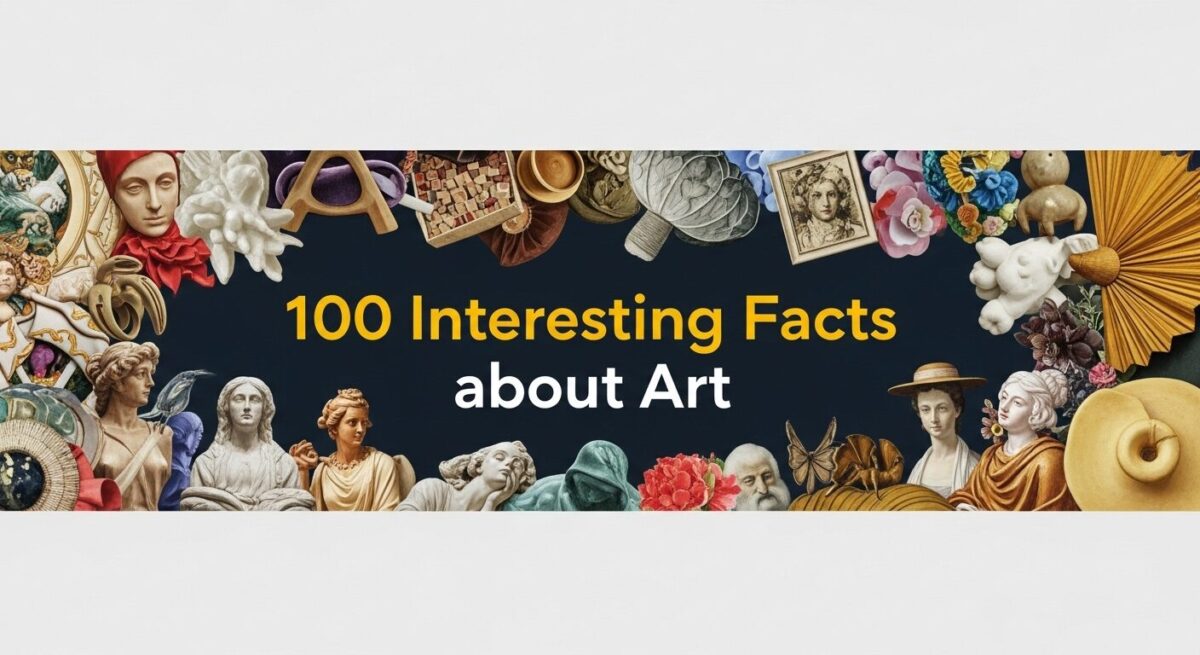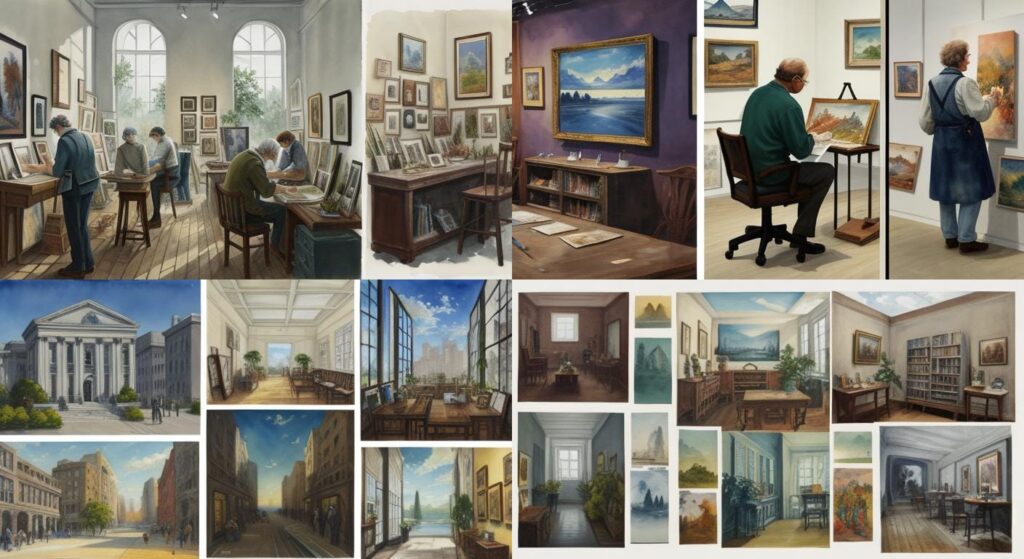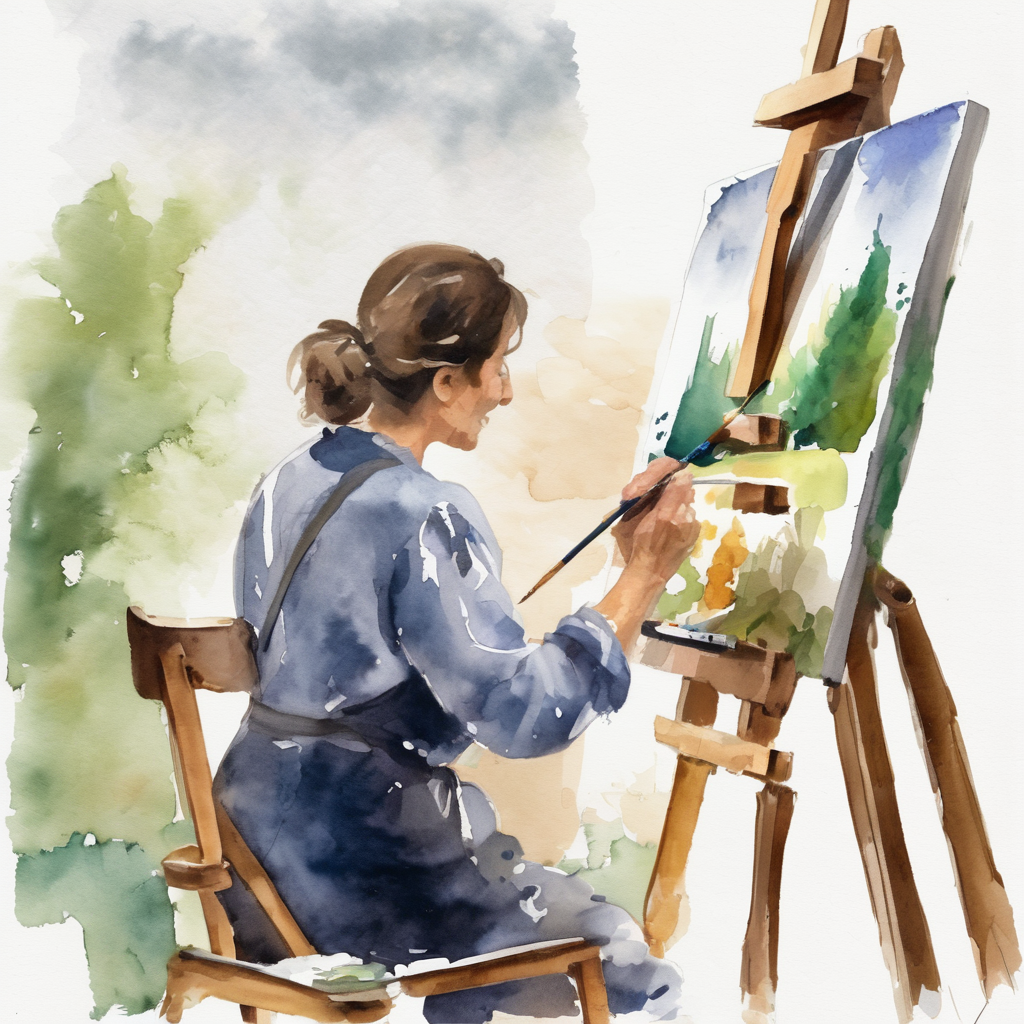Think you know art? Think again. The world of painting, sculpture, and creation is so much more than just a bunch of pretty pictures on a wall. It’s filled with secrets, wild stories, and some seriously weird facts that will blow your mind. Imagine a famous painter who used to sell his leftover paints to pay for food, or a sculpture that was so heavy it broke the floor of the museum it was in. Get ready to peel back the layers and discover 100 interesting facts about art that are so crazy, you’ll wonder why they didn’t teach you this in school.
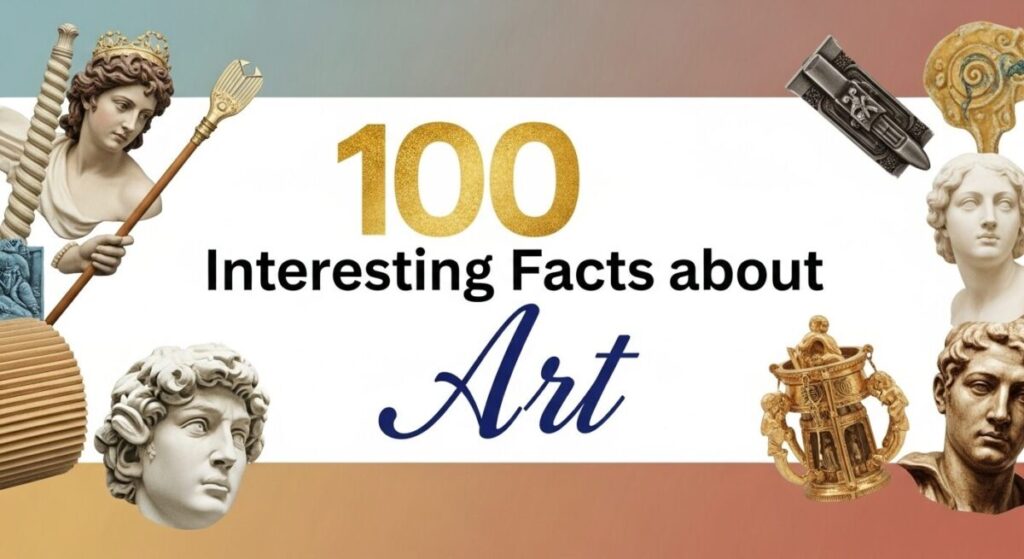
The Ancient and Mysterious
- What is the oldest known cave painting? The oldest known cave painting is found in Indonesia and is a portrait of a wild pig, painted over 45,500 years ago. Talk about a long-lasting masterpiece!
- Ancient Romans had mosaics in their homes that were like a “Beware of Dog” sign. They often featured a dog with the Latin words “Cave Canem” (pronounced: kah-vay kah-nem).
- The Sphinx in Egypt originally had a beard, but it fell off. You can still see parts of it in the British Museum.
- The famous Greek sculpture, the Venus de Milo, is missing both of her arms. No one knows for sure how they were lost, but some think they were broken off during a fight between two sailors who found her.
- Ancient Egyptian artists didn’t sign their work. They believed that art was for the gods and pharaohs, not for an individual’s fame.
- The pigment “Egyptian Blue” was created over 4,600 years ago and was the first synthetic pigment ever made. It was so popular it was used all over the Roman Empire.
Artists with Quirky Habits
- Was da Vinci a vegetarian? Leonardo da Vinci was a vegetarian and an animal lover. He would often buy caged birds just to set them free.
- Michelangelo was known for being super grumpy and rarely took baths. He often slept in his clothes, so they became part of his skin! Gross, but true.
- Vincent van Gogh was a total workaholic, and he often painted with a hat full of lit candles to see in the dark.
- The famous French painter Henri Matisse painted some of his greatest works from a wheelchair. He called his new artistic style “drawing with scissors.”
- Georgia O’Keeffe, known for her giant flower paintings, was a pro at making her own clothes and often wore simple, black dresses.
- Salvador Dalí, the king of weird art, had a pet ocelot named Babou, who he took everywhere with him, even to fancy restaurants.
- Pablo Picasso was so afraid of the police that he carried a pistol loaded with blanks. He’d fire it at people who annoyed him.
The Shocking Secrets of Famous Paintings
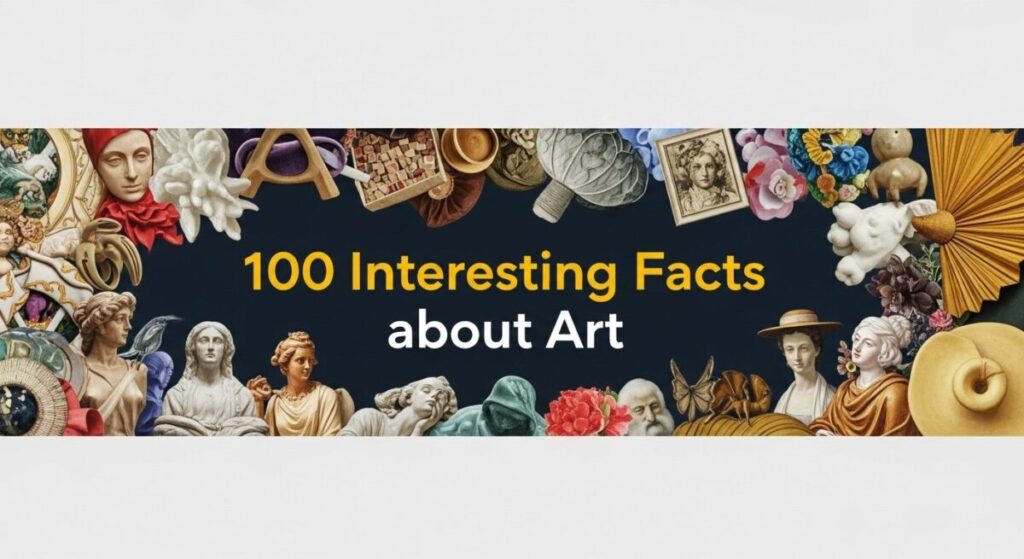
- Why did the Mona Lisa have no eyebrows? The Mona Lisa has no eyebrows! It was the fashion back in the Renaissance to shave them off.
- The “Scream” by Edvard Munch isn’t about the person screaming. It’s about a person reacting to a scream-like sound from nature. The swirling lines in the painting represent the sound moving through the air.
- The “Last Supper” by Leonardo da Vinci is a giant mural, not a painting on a canvas. It’s painted on a wall in a monastery in Milan and has been slowly crumbling for centuries.
- In the painting “American Gothic,” the man and woman are not husband and wife; they are the artist’s dentist and his sister.
- There’s a hidden self-portrait of Caravaggio in his painting “David with the Head of Goliath.” The head of Goliath is actually the artist’s own face.
- Many people think that Van Gogh’s “Starry Night” is a painting of a specific place, but it was actually painted from his memory while he was in an asylum.
- The sky in “The Scream” might actually represent a real event. Some art historians believe the fiery colors are based on the volcanic sunset after the 1883 eruption of Krakatoa.
- The artist Johannes Vermeer used a camera obscura, a kind of early camera, to help him create his incredibly realistic paintings. You can see the magic of light and shadow in his works like “Girl with a Pearl Earring.”
- The painting “The Night Watch” by Rembrandt isn’t a night scene at all. It was covered in so much grime and dark varnish over the years that people thought it was. When it was cleaned, everyone was surprised to find it was a daytime scene.
- The famous painting “The Kiss” by Gustav Klimt is so popular that it has been reproduced on everything from coffee mugs to phone cases. It’s a great example of Symbolism.
Art Heists, Mishaps, and Mayhem

- The Mona Lisa was stolen from the Louvre in 1911 and was missing for two years. An Italian handyman, who thought it belonged in Italy, was caught with it.
- In 1972, a man took a hammer to Michelangelo’s “Pietà” sculpture in St. Peter’s Basilica. He screamed, “I am Jesus Christ, risen from the dead!” as he smashed it. Luckily, it was repaired.
- One of Claude Monet’s “Water Lilies” paintings was so big that it had to be cut into three pieces to be moved. It’s a good thing he made a lot of paintings!
- In 1990, the biggest art heist in history happened at the Isabella Stewart Gardner Museum in Boston. Thirteen works of art, worth over $500 million, were stolen, and the case is still unsolved.
- A student once fell on a Pablo Picasso painting at the Metropolitan Museum of Art, and the painting was badly ripped. Oops! Luckily, it was restored perfectly.
- The most expensive painting ever sold at auction is “Salvator Mundi,” attributed to Leonardo da Vinci, which sold for over $450 million in 2017. Some art historians aren’t even sure if it was painted by him!
Materials and Methods: The Good, the Bad, and the Bizarre
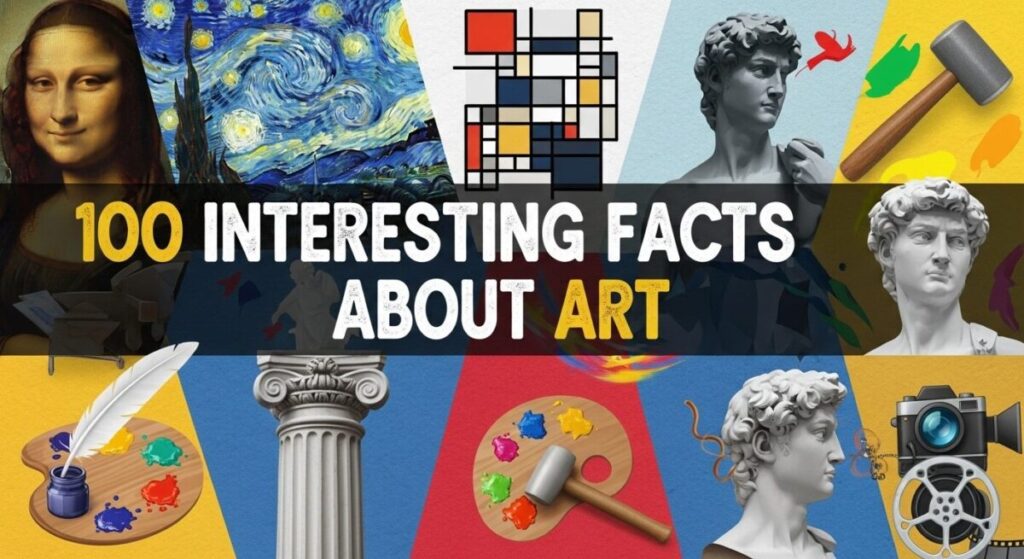
- Before synthetic paints, artists used to grind up all sorts of things for color. “Indian Yellow” was made from the urine of cows fed only mango leaves.
- The color “mummy brown” was literally made from grinding up mummified ancient Egyptians. It was popular in the 17th century but thankfully fell out of favor.
- The purple dye used to be so expensive that only royalty and super-rich people could afford it. It was made from thousands of tiny snails.
- Some artists in the Middle Ages used egg yolk to bind their pigments together, creating a type of paint called tempera.
- The color “ultramarine blue” used to be more expensive than gold. It was made from a rare mineral called lapis lazuli, which was only found in Afghanistan.
- The pigment “cochineal red” is made from crushed beetles. You might find this same pigment (as “carmine”) in some foods and lipsticks today.
- The famous “fresco” painting technique involves painting on wet plaster. As the plaster dries, the pigment becomes a permanent part of the wall, making it last for a very long time.
- Ancient Greeks and Romans used melted wax as a paint binder, a technique called encaustic painting. This technique is still used today.
| Painting Style | Time Period | Key Characteristics | Famous Example |
| Renaissance | 14th–17th century | Realism, perspective, human anatomy, and emotion. | The Last Supper by Leonardo da Vinci |
| Impressionism | Late 19th century | Short brushstrokes, light, and everyday subjects. | Water Lilies by Claude Monet |
| Cubism | Early 20th century | Broken shapes, geometric forms, multiple viewpoints. | Les Demoiselles d’Avignon by Pablo Picasso |
| Surrealism | 1920s-1930s | Dream-like scenes, illogical imagery, mind exploration. | The Persistence of Memory by Salvador Dalí |
| Abstract Expressionism | Mid-20th century | Emotional expression, large canvases, non-representational. | No. 5, 1948 by Jackson Pollock |
From Bizarre to Beautiful: More Art Facts
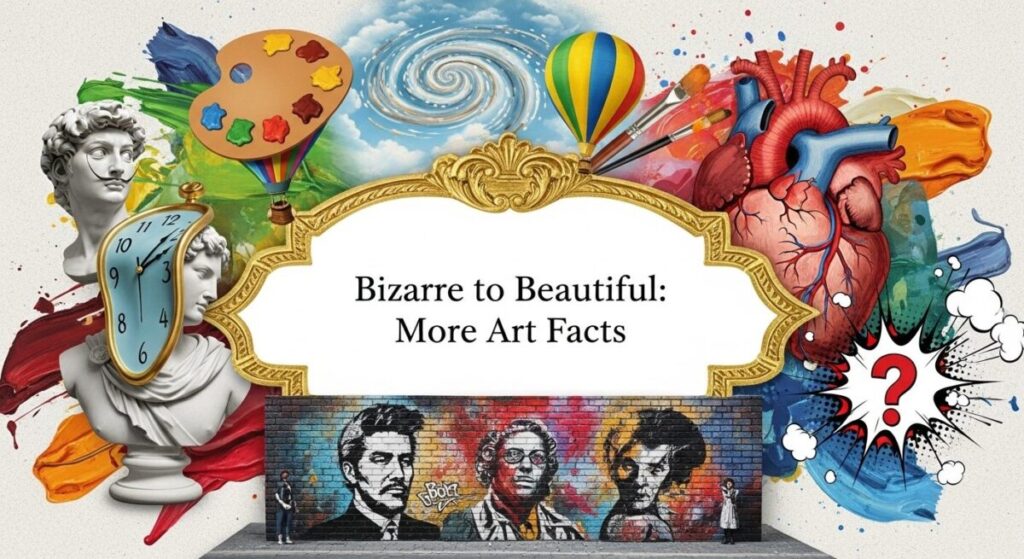
- The word “art” comes from the Latin word “ars,” which means “skill.”
- The ancient Romans loved sculptures so much that they made copies of famous Greek ones. That’s why we have so many famous Greek sculptures today—they are Roman copies!
- The first person to be arrested for a crime was an artist. In 1492, the painter Bartolomeo de Lira was caught with a forged passport.
- In ancient times, sculptors often left their work unfinished on purpose. This was a trend in the Renaissance, where it showed that the sculpture was so lifelike it was still being “born” from the stone.
- The “Guernica” by Pablo Picasso is one of the most powerful anti-war paintings ever made. He painted it to show the world the suffering caused by the bombing of a small town during the Spanish Civil War.
- The first art museum, the Ashmolean Museum in Oxford, England, opened its doors to the public in 1683.
- The famous sculpture “The Thinker” by Auguste Rodin was originally meant to be a small figure on a larger door, but it became a masterpiece on its own.
- In ancient China, some artists were also scientists and engineers. They created detailed drawings of plants and animals for medicinal books.
- The Sistine Chapel ceiling, painted by Michelangelo, took him four years to complete. He spent most of that time on his back, with paint dripping into his eyes. Ouch!
- The phrase “Starving Artist” is a real thing. Many famous painters like Van Gogh and Monet struggled to sell their work and lived in poverty for a long time.
- The most reproduced painting in the world isn’t the Mona Lisa—it’s Van Gogh’s “Sunflowers.”
- The famous quote, “Every child is an artist. The problem is how to remain an artist once we grow up,” was said by Pablo Picasso. This is a great quote for anyone starting on their painting with acrylics journey.
- The artist Jackson Pollock, known for his “drip paintings,” didn’t use an easel or a brush. He would lay a giant canvas on the floor and drip, pour, and splash paint onto it.
- The ancient Mayans used different types of clay and minerals to create vibrant murals. They were especially known for their bright blue color.
- The famous statue of David by Michelangelo was carved from a single block of marble that another sculptor had already given up on.
- The earliest form of abstract art was created by the artist Wassily Kandinsky. He believed that colors and shapes had their own “spiritual” language.
- The world’s largest painting is a mural called “The Meeting of the Two Saints,” located in Saudi Arabia. It’s over 1,000 square meters!
- The color “vermilion red” was made from a poisonous mineral called cinnabar. Many artists who used it became sick from mercury poisoning.
- The Renaissance artist Titian was so good at painting that it’s said he could paint with his fingers as well as a brush.
- The sculpture “The Little Dancer Aged Fourteen” by Edgar Degas was so lifelike that people thought it was a real person in a case at an art show.
- The first photograph ever taken was in 1826 by a French inventor, Nicéphore Niépce. It was a view from a window and took eight hours to expose!
- Some artists, like Rembrandt, were known for using a technique called chiaroscuro, which uses strong contrast between light and shadow. This gives paintings a dramatic, spooky feel.
- The artist Jean-Michel Basquiat started out as a graffiti artist in New York City. His work sold for millions of dollars, but he always felt like an outsider in the art world.
- The world’s largest art museum is the Louvre in Paris, but it’s not a single building. It’s a series of buildings, and if you spent one minute looking at every piece of art, it would take you over 100 days to get through the whole thing.
- The ancient Greeks believed that the Muses, goddesses of the arts, inspired artists.
- The painting “The Persistence of Memory” by Salvador Dalí, with its famous melting clocks, was inspired by a piece of Camembert cheese melting in the sun.
- The word “sculpture” comes from the Latin word “sculpere,” which means “to carve.”
- In the 18th century, a group of artists in England painted pictures of dogs playing poker. The paintings were so popular that they became a famous series!
- The artist Frida Kahlo suffered from a bus accident that left her in pain for the rest of her life. She painted many self-portraits while lying in her bed, using a special easel.
- The famous painter Vincent van Gogh only sold one painting in his lifetime, “The Red Vineyard.” All his other work became famous after he died.
- The ancient city of Pompeii was covered in volcano ash, which preserved the buildings and their beautiful frescoes and mosaics.
- The first piece of art to be bought with cryptocurrency was a painting by the artist named “Bansky,” who is still anonymous.
- In ancient Rome, it was common for artists to sign their work in a hidden spot, like in the background of a painting.
“Creativity takes courage.”
Henri Matisse
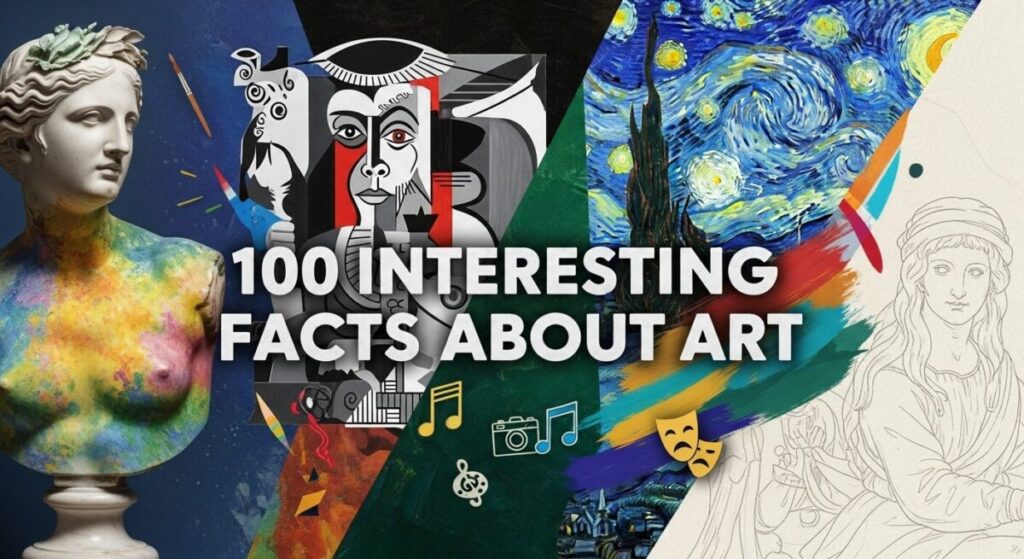
- The “Thinker” statue by Rodin was originally placed in front of a museum, but a person once fell over and broke it. The artist said it was a good thing because it was a sign of its power.
- The famous painting “The Starry Night” by Van Gogh was actually painted while he was in a mental asylum.
- A famous art critic once called a painting “a collection of splatters and smudges.” The painting was by Claude Monet and is now a priceless masterpiece.
- The artist Andy Warhol, known for his Pop Art, once said he wanted to be “a machine.” He created many of his works by using silkscreen printing, which is a kind of mechanical process.
- The first use of perspective in painting was in the Renaissance. Artists learned how to make things look like they were far away, which made paintings more realistic.
- The famous painting “The Scream” has been the target of several thefts. It was stolen in 1994 and again in 2004, but both times it was recovered.
- The painter Pablo Picasso made over 50,000 pieces of art in his lifetime, including paintings, sculptures, and drawings.
- The ancient Chinese invented paper-making, which made it easier for artists to create and share their work.
- The most expensive sculpture ever sold is “L’Homme au doigt” (Man Pointing) by Alberto Giacometti, which sold for over $141 million.
- The artist Yayoi Kusama, known for her polka dots, is one of the most popular living artists in the world. Her work is so popular that people wait in line for hours to see her exhibits
- The original name for the Statue of Liberty was “Liberty Enlightening the World.” It was given to the United States as a gift from France and the copper skin has a green patina from reacting with the air over time.
- The famous “Mondrian” paintings with their straight lines and primary colors were so carefully planned that the artist, Piet Mondrian, would take months to finish a single canvas.
- A piece of modern art was once mistaken for a pile of trash by museum cleaners and was accidentally thrown away. It was a sculpture made from pieces of paper and cardboard.
- The famous bronze statue “The Little Mermaid” in Copenhagen, Denmark, has been vandalized multiple times. She has been beheaded twice and had her arm sawed off once.
- The artist Michelangelo, while painting the Sistine Chapel ceiling, would often write poetry on the walls to vent his frustration.
- The famous Pop Art painting of a Campbell’s Soup Can by Andy Warhol was so successful that Campbell’s started selling a limited edition of the soup cans to celebrate.
- A famous street artist named Invader has created mosaics of video game characters like Space Invaders and placed them on buildings all over the world.
- The most expensive photograph ever sold was “Rhein II” by Andreas Gursky, which sold for over $4.3 million.
- The ancient Romans loved to paint portraits of their deceased loved ones on wooden panels, which were then placed on their graves.
- The famous painting “The Great Wave off Kanagawa” by Hokusai is not a painting of a tsunami; it’s a painting of a giant wave that looks like a monster, with tiny boats being tossed about.
- The artist Jean-Michel Basquiat had a pet parakeet that he kept in his studio and often included in his paintings.
- The famous painting “Christina’s World” by Andrew Wyeth is a portrait of a real woman, who was the artist’s neighbor. She was crippled by a disease and the painting shows her determination to crawl up a hill toward her house.
- The artist Banksy once had a painting self-destruct after it was sold at an auction for over a million dollars. The painting, “Girl with a Balloon,” was shredded by a mechanism hidden in the frame.
- The first art gallery was in Florence, Italy, and it was called the Uffizi Gallery. It was originally built to house the offices of a rich family, but it was so beautiful they decided to display their art collection there.
- The word “pastel” comes from the Italian word “pastello,” which means “little stick,” and it’s a kind of dry paint that looks like a crayon.
- The famous painting “The Creation of Adam” on the Sistine Chapel ceiling has a hidden message. Some scholars believe that the image of God is actually a hidden diagram of the human brain.
- The ancient Egyptians had a symbol for “life” called the Ankh, which was often found in their tomb paintings and on sarcophagi.
- The famous sculpture “The Kiss” by Auguste Rodin was originally part of a larger, unfinished work called “The Gates of Hell.”
- The artist Claude Monet once had a problem with his eyesight that made him see colors differently. He still painted, but his later works have a reddish-brown color to them.
- The famous painting “Whistler’s Mother” by James McNeill Whistler is actually titled “Arrangement in Grey and Black No. 1,” and it’s meant to be a study of form and color, not a portrait of a person.
Interesting Facts for 2025
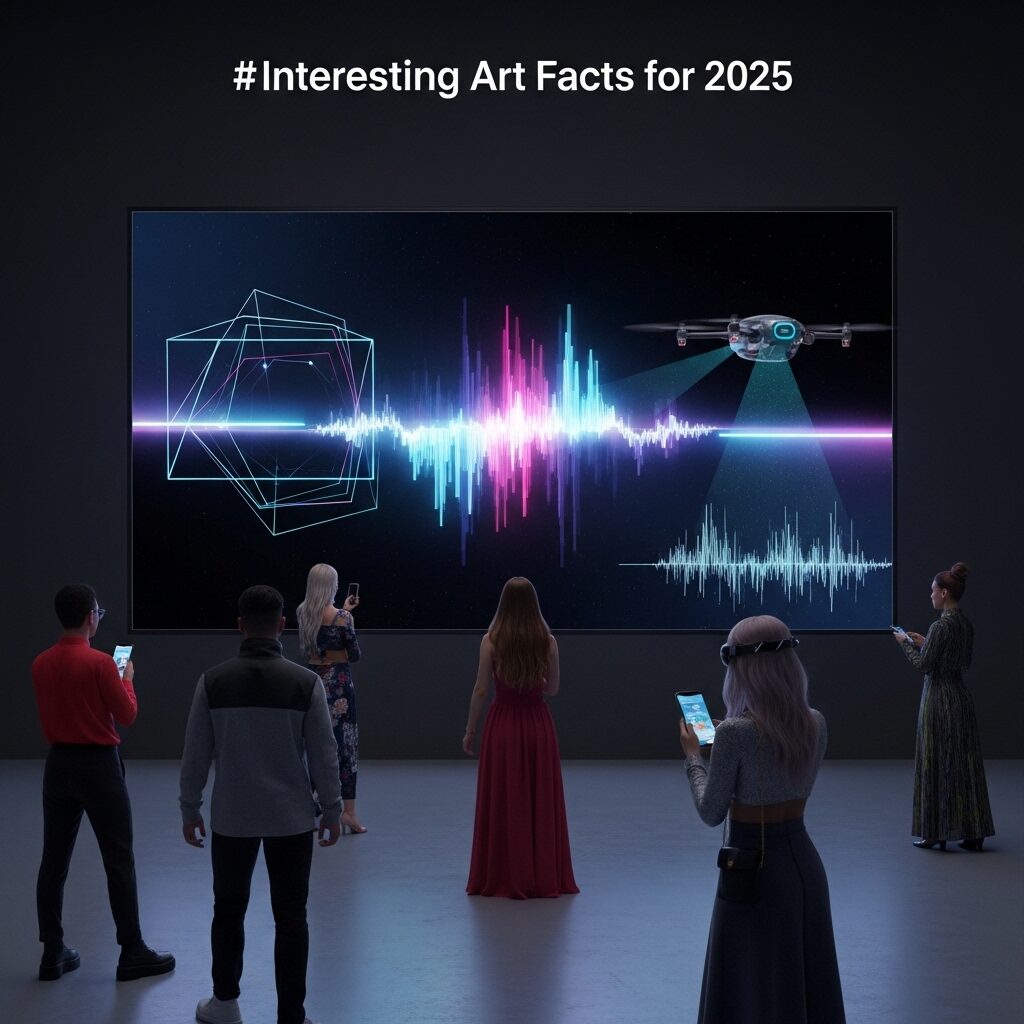
- AI Is the New Artist’s Assistant. In 2025, artificial intelligence (AI) is no longer just for sci-fi movies. Artists are using AI tools to brainstorm ideas, create sketches, and even finish entire pieces. This has led to some amazing, never-before-seen works that blend human creativity with machine precision, blurring the line between who—or what—is the true artist.
- Eco-Art is Making a Splash. The climate crisis is a huge theme in 2025’s art scene. Many artists are using their work to speak out about environmental issues. They’re not just painting pictures of nature; they’re creating art from recycled materials, soil, and even water. Some artists are even making pieces designed to dissolve over time, sending a powerful message about the fragility of our planet.
- The Art Market is Going Digital. Forget dusty auction houses—in 2025, the art market is becoming more digital than ever. Younger generations are leading the charge, using online platforms and social media to discover and buy art. This shift is making the art world more accessible and transparent, especially for emerging artists and new collectors.
- Old Masters are Back in Style. In a world that feels a little chaotic, collectors are looking for a sense of history and stability. This has led to a major comeback for “Old Masters” art (art from before the 1800s). In fact, sales of this type of art have seen a huge increase in 2025, showing that sometimes, the classics are a sure bet.
- A Lost Egyptian Tomb Has Been Found. Early in 2025, archaeologists working in Egypt’s Valley of the Kings announced a groundbreaking discovery: the possible burial site of King Thutmose II. This is the first time the funerary furniture of this particular king has been identified, and it’s being called one of the most important archaeological discoveries in recent years. This incredible find gives us a new window into ancient art and culture.
- Art is Getting Mixed Up. Artists in 2025 are throwing out the rulebook when it comes to materials. Mixed media art is exploding in popularity. Artists are combining paint, wood, metal, fabric, and even sound and light into a single piece. This trend is all about creating a full sensory experience that pulls the viewer into the artwork itself.
- Street Art is Going Big. Street art, from graffiti to murals, has long been an important part of art culture. In 2025, it’s not just in the back alleys anymore; it’s a major force. More and more cities are commissioning large-scale murals and public art projects, recognizing the power of art to beautify spaces and create a sense of community.
- The Rise of Biophilic Art. People living in big cities are craving a connection to nature. This has led to the rise of “biophilic” art, which is inspired by natural elements. Think art with earthy tones, botanical themes, and subtle floral patterns that make you feel like you’re in a peaceful garden, even if you’re stuck in a concrete jungle.
- Ancient Frescoes Reborn in London. In a surprise archaeological find, experts in London have painstakingly reassembled over 400 fragments of Roman frescoes that were once part of a Roman townhouse. Dating back to the 1st or 2nd century, the reassembled mural features beautiful birds, lyres, and ivy leaves, giving us a rare look into Roman art in ancient Britain.
- Art is a Form of Therapy. In a fast-paced world, more people are turning to art as a way to relax and de-stress. Art therapy, coloring books for adults, and simple sketching are all becoming popular tools for mental wellness. This trend shows that art isn’t just for looking at—it’s also for doing and for healing.
FAQs
Q: What are 10 fun facts about art?

A: Art is full of fun surprises! The Mona Lisa doesn’t have eyebrows because it was fashionable to shave them off in the Renaissance. Vincent van Gogh only sold one painting during his life. The color “mummy brown” was literally made from ground-up mummies. The famous “The Scream” painting is about a reaction to a sound, not the person screaming. And the sculpture “The Thinker” by Rodin was originally a small figure on a larger door.
Q: What are some weird facts about artists?
A: Artists can be very quirky! Salvador Dalí had a pet ocelot named Babou. Michelangelo was known for being a bit stinky and sleeping in his clothes. Pablo Picasso carried a pistol loaded with blanks to fire at people who bothered him. Vincent van Gogh often painted at night with candles on his hat. And Leonardo da Vinci was a huge animal lover and vegetarian who would buy caged birds just to set them free.
Q: What is a fun fact about Michelangelo?
A: A fun fact about Michelangelo is that he was so dedicated to his art that he often slept in his clothes, and he was known for being quite dirty. He once wrote a poem describing how uncomfortable it was to paint the Sistine Chapel ceiling while lying on his back, with paint dripping into his eyes and his body aching.
Q: What is a cool fact about Leonardo da Vinci?
A: A cool fact about Leonardo da Vinci is that he was a genius in many different fields. He wasn’t just a painter; he was also an inventor, a scientist, a musician, and a writer. He filled thousands of pages with his notes and drawings, including ideas for things like helicopters and tanks, centuries before they were ever invented.
Citations:
Khan Academy. “Leonardo da Vinci’s Mona Lisa.”
The Metropolitan Museum of Art. “Michelangelo Buonarroti – David-Apollo.”
National Gallery of Art. “Little Dancer Aged Fourteen by Edgar Degas.”
National Gallery of Art. “Edgar Degas Only Made One ‘Little Dancer.’ And It’s Ours.”
Britannica. “Mona Lisa: Painting, Painter, History, Meaning, & Facts.”
Victoria and Albert Museum. “The story of Michelangelo’s David.”

